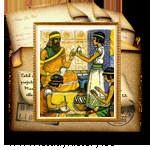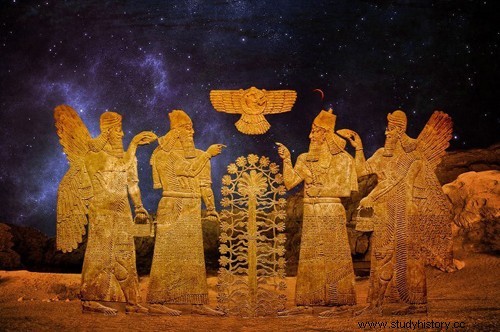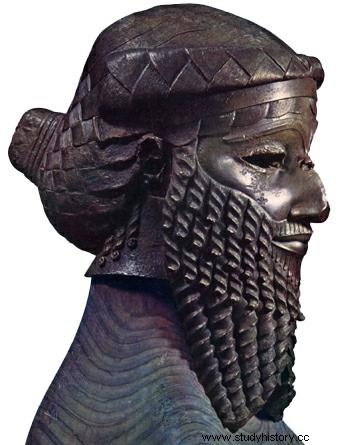 The beginning of Sumerian history contains many mysteries. Historians and archaeologists have spent a lot of effort trying to unravel them. Now we know what the Sumerians looked like, what gods they believed in, how they ran the household, raised children. Archaeologists walk the streets of ancient Sumerian cities, restore the location of houses and temples. However, there are no fewer mysteries. As knowledge accumulates, new questions arise. And the main one - where did the Sumerians come from, where is their homeland?
The beginning of Sumerian history contains many mysteries. Historians and archaeologists have spent a lot of effort trying to unravel them. Now we know what the Sumerians looked like, what gods they believed in, how they ran the household, raised children. Archaeologists walk the streets of ancient Sumerian cities, restore the location of houses and temples. However, there are no fewer mysteries. As knowledge accumulates, new questions arise. And the main one - where did the Sumerians come from, where is their homeland?
The country of Sumer takes its name from a people who settled around 3000 BC. e. in the lower reaches of the Euphrates River, not far from its confluence with the Persian Gulf. The Euphrates is divided here into numerous channels-sleeves, which then merge, then diverge again.
Small villages were located quite far from the water, since the Euphrates floods very violently and unexpectedly in summer, and floods were always very dangerous here (the memory of the great floods was preserved in Sumerian legends). People tried not to go into the endless reed beds, although very fertile lands were hidden under them. They were formed from silt that settled during floods. But in those days, the cultivation of these lands was still beyond the power of people. They knew how to harvest only from small open areas, resembling vegetable gardens rather than fields in their size.
Everything changed when the country of rivers and swamps got new, energetic masters - the Sumerians. The Sumerians were very different from the peoples around them - and above all in their language. Today, scholars can read Sumerian texts, and multi-volume dictionaries of the Sumerian language have already been compiled. This took many decades of hard work, and scientists were wrong more than once. Gradually it became clear that the ancient Sumerian language is not like any of the ancient and modern languages. Therefore, we cannot say with which peoples of antiquity the Sumerians “were related”, although scientists tried to find their “relatives” in the Caucasus, the Himalayas, and the Pamirs. We are unlikely to ever know the whole truth about their distant homeland.
Let's see how the Sumerians behaved in an unfamiliar place for them, among reed beds and swamps. In addition to fertile, but not yet developed lands, the new homeland of the Sumerians could only boast of a large amount of clay and reeds. There were no tall trees, no stone suitable for construction, no ores from which metals could be smelted. The Sumerians learned to build houses from clay bricks; the roofs of these houses were covered with thatch. Such a house had to be touched up every year, smearing the walls with clay so that it would not fall apart. Abandoned houses gradually turned into shapeless hills, because. bricks were made from unbaked clay. The Sumerians often left their homes when the Euphrates changed course, and the settlement was far from the coast. There was a lot of clay everywhere, and in a couple of years the Sumerians managed to “blind” a new village on the banks of the river that fed them. For fishing and river travel, the Sumerians used small round boats woven from reeds, coating them with resin on the outside.
The abundance of clay, from which houses and dishes, utensils and children's toys were made, suggested to the Sumerians the idea of writing on clay tablets. The scribe worked like this:a small flat tablet was made from wet clay, on which letters were applied with a sharp stick. It is difficult to draw lines of the same thickness on viscous clay, so they turned out to look like triangles or wedges. Historians call Sumerian writing "cuneiform". Not very necessary records could then be erased, and tablets with important documents were burned on fire, and they became hard as a stone. The earliest records belong to temple officials - they had to count how much grain, oil and meat was produced on the farm, how much was given to workers for food, how much was left at the disposal of the temple. Archaeologists have learned how to fold even broken tablets and read what is written on them.
With fertile land, the Sumerians eventually realized what high yields could be obtained by draining the swamps and bringing water to dry areas.
Irrigating fields in Mesopotamia was a tricky business. When too much water flowed through the canals, it seeped underground and connected with underground groundwater, and they are salty in Mesopotamia. As a result, again, salt, along with water, was brought to the surface of the fields, and they quickly deteriorated; wheat on such lands did not grow at all, and rye and barley gave low yields. In the end, the salty fields were simply abandoned or sheep were grazed on them. The Sumerians did not immediately learn how to determine how much water was needed for proper watering of the fields:excess or lack of moisture was equally bad. Under these conditions, it would be most reasonable to direct the irrigation of fields from one place, and not to trust each peasant to break through irrigation ditches as he pleases.

Temples became such centers for managing agriculture, and therefore the whole life of people, in Sumer. In large temple farms there were many priests who were specially engaged in measuring land plots, organized the laying of canals, and counted the harvest. It was the temple that controlled the life of neighboring cities and villages, collected taxes from the population, and distributed food in famine years. Historians call the people uniting around the temple a temple community.
Why was it not the king who did all these things, as was the case in Egypt? The fact is that Sumer for seven centuries of its history did not represent a single state:the regions of the country were separated from each other by the channels of the Euphrates and swamps, as well as by the peculiarities of development. The center of each region was a strong and wealthy city that arose around a temple dedicated to the local god. The most famous of the Sumerian cities were Ur, Uruk, Nippur, Kish, Lagash, Umma. In total, there were several dozen such independent cities and regions. The city and the region were ruled by the priests of the main city temple; the high priest most often bore the title "en" or "ensi". Least of all, the commander of the city militia, called "lugal", was associated with the temple. However, lugals often came from priestly families. For a long time, the power of the priests in Sumer was much stronger than the power of the military leaders.
The special position of the priests in Sumer was reinforced by the cunning organization of the temple economy. At first, the temples did not have their own land. Each village simply allocated a special section of the field to the "god". All the peasants processed it together, and the village community gave the harvest collected from this site to the temple. Gradually, the temples took these lands from the communities and began to run their own economy on them. There were also people dependent on them who worked in the temple fields for food rations. At first, there were still a few slaves in Sumer, and their labor did not play a big role in the economy. In Sumer, the buying and selling of land was permitted by law very early. Taking advantage of this, the temples constantly increased their possessions; more and more landless peasants were forced to work as laborers on the temple fields. The temple rented out part of the fields. Any person could take a piece of land and run a household on it, giving the priests part of the crop. It turned out that every peasant could count on help from the temple:the temple provided the poor man with a piece of bread, the poor peasant - the opportunity to cultivate an additional piece of land, and the rent made it possible for the strong owner to expand production and sell part of the crop on the market. Therefore, all the peasants in Sumer held fast to the temples and often took the side of the priests during their quarrels with the lugals, and later with the kings.
And clashes between temples and lugals were becoming more frequent in Sumer. Lugali sought to conquer neighboring cities, unite the country and declare themselves kings. To do this, they needed to turn the city army into their own squad, obedient to all the orders of the leader. However, the lugal did not have the means to support such an army, so he began to bargain with the temples and asked them for land to distribute to his soldiers. In return, the lugal apparently promised the priests the conquest of rival cities and rich gifts from war booty. Sometimes the lugal managed to gain access to the temple lands, and then the shameless robbery of the temple property began:the lugal drove the peasants from the fields, planted his warriors instead of them, canceled the distribution of food to the population, transferred the temple land by inheritance to his sons.
What changed in the Sumerian cities after the transition of power to the warlords? The answer to this question is given by the history of Lagash.
Circa 2400 BC e. Lugal Eanatum seized power in this city. Using the wealth of the city's temples, he waged successful wars with neighboring cities and forced them to recognize the dominance of Lagash. At the same time, thousands of people died; rivals often destroyed the dams on the Euphrates and flooded each other's fields and villages. The victories won at such a price did not please the entire population. Riots began in Lagash, and one of Eanatum's successors, Uruinimgin, was forced to return the temples to their lands and restore many of the ancient customs. But it was already too late. Lagash was so weakened by internal strife that in the struggle for disputed lands it was defeated by its eternal rival, the neighboring city of Umma.
None of the Sumerian lugals were strong enough to unite the country under their rule. Shortly before 2300 BC. e. riots in the Sumerian cities and wars between cities acquire a particularly destructive character. But seven centuries of Sumerian history brought not only destruction and civil strife. The Sumerians created a rich and complex culture that became a role model throughout Mesopotamia. Sumerian cuneiform was subsequently used by many peoples who adapted it to their languages.
The Sumerians were endowed with a very strong religious feeling. Their ideas about the gods, the beginning of the world, human destiny were reflected in many Eastern religions. Many Sumerian traditions were adopted by the ancient Jews, and later they were recorded in the Bible. The Sumerians showed an amazing craving for scientific knowledge about the world:before the Greeks, they were the best mathematicians and astronomers of antiquity.
The knowledge accumulated by the ancestors was passed on to boys and youths in numerous temple schools. Here they taught to read cuneiform, keep business records, observe the starry sky, accurately determine the area of land. The Sumerians highly valued wisdom, which, in their opinion, was concentrated in the ears of man; therefore, many images of people were distinguished by their large protruding ears. We will better understand the nature of the Sumerians, appreciate their love of knowledge, if we compare these images with portraits, for example, of Assyrian kings, warlike and ruthless. Sumerian rulers often commanded to be photographed in a special "builder's pose" - with a drawing of a building spread out on their knees, with a small bucket of wet clay placed at their feet. This people loved to build more than to fight, and the image of the creator, according to the Sumerians, was more suitable for the ruler than the image of a warrior.

Maybe that's why the Sumerians never managed to create a unified kingdom. The person who was able to do this turned out to be not a Sumerian, but an Akkadian. His name was Sargon, although this is most likely not a name, but one of the titles he took after defeating his rivals. Akkadians also lived in Mesopotamia, north of the Sumerians. Initially, they were nomadic pastoralists, later they turned to agriculture and maintained close relations with the Sumerians. Taking advantage of the strife between the lugals, Sargon first fortified himself in the north of Sumer, in a few years he created a strong army, armed it with long-range bows (the Sumerian warriors used only a sword and a spear in battle), and soon captured the south of the country. Sargon did not take any of the honorary Sumerian titles and did not choose any of the ancient Sumerian cities as his capital. He began to call himself the king of Sumer and Akkad and built a new capital - the city of Akkad. Sargon established control over all temple households, but in return he constantly gave the temples rich gifts. Sargon created a large number of bureaucratic positions, and many of the people who fed near the temples moved to the royal service.
The Sumerian nobility repeatedly rebelled against the power of Sargon (later called the Ancient One) and his heirs, but the sons of Sargon, Rimush and Manishtushu, destroyed the disaffected, simply slaughtering the most powerful families of the nobility. A powerful Sumero-Akkadian kingdom arose, which existed for about a hundred years, approximately from the 2300s to the 2200s. BC e. It reached its highest rise under the grandson of Sargon, Naram-Sin (2236-2200 BC). Naram-Sin felt so confident that he tried to deify the personality of the king and rule the country on his own, without relying on temples.
After the emergence of the Sumero-Akkadian kingdom, the Sumerians began to gradually mix with the Akkadians and other steppe peoples; at the same time, Sumerian culture spread widely in Mesopotamia and outlived the people who created it for many centuries.
From the Historical Encyclopedia
